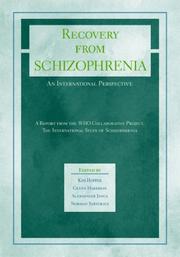| Listing 1 - 3 of 3 |
Sort by
|

ISBN: 1280846887 0195345495 1429459484 9781429459488 9780195313673 0195313674 9781280846885 0197708498 Year: 2007 Publisher: Oxford New York Oxford University Press
Abstract | Keywords | Export | Availability | Bookmark
 Loading...
Loading...Choose an application
- Reference Manager
- EndNote
- RefWorks (Direct export to RefWorks)
In the late 1960's, the World Health Organization initiated a series of international studies of the incidence, characteristics, course, and consequences of schizophrenia. Those studies - the largest ever in the history of psychiatry - provided important data about the disorder in groups of patients living in different countries and cultures, and first focused attention on the differences in short-term prognosis for schizophrenia between the third world and industrialized countries. In the 1990's, the International Study of Schizophrenia (ISoS) set out to relocate those subjects and to determine
Schizophrenia --- Psychoses. --- Psychosis --- Psychotic disorders --- Psychology, Pathological --- Dementia praecox --- Schizophrenic disorders --- Psychoses --- Schizotypal personality disorder --- Epidemiology. --- World Health Organization. --- Follow-Up Studies. --- International Cooperation. --- Treatment Outcome. --- therapy.
Book
Year: 2007 Publisher: Washington, D.C., The World Bank,
Abstract | Keywords | Export | Availability | Bookmark
 Loading...
Loading...Choose an application
- Reference Manager
- EndNote
- RefWorks (Direct export to RefWorks)
Using an "event-study" methodology, this paper analyzes the aftermath of civil war in a cross-section of countries. It focuses on those experiences where the end of conflict marks the beginning of a relatively lasting peace. The paper considers 41 countries involved in internal wars in the period 1960-2003. In order to provide a comprehensive evaluation of the aftermath of war, the paper considers a host of social areas represented by basic indicators of economic performance, health and education, political development, demographic trends, and conflict and security issues. For each of these indicators, the paper first compares the post- and pre-war situations and then examines their dynamic trends during the post-conflict period. The paper concludes that, even though war has devastating effects and its aftermath can be immensely difficult, when the end of war marks the beginning of lasting peace, recovery and improvement are indeed achieved.
Civil Conflict --- Civil War --- Conflict and Development --- Demographic Trends --- Disability --- Diseases --- Economic Growth --- Health Consequences --- Health, Nutrition and Population --- Life Expectancy --- Malaria --- Peace --- Peace and Peacekeeping --- Policy --- Policy Research --- Policy Research Working Paper --- Political Instability --- Population --- Population Policies --- Populations --- Post Conflict Reconstruction --- Progress --- Refugees --- Wars --- World Health Organization
Book
Year: 2007 Publisher: Washington, D.C., The World Bank,
Abstract | Keywords | Export | Availability | Bookmark
 Loading...
Loading...Choose an application
- Reference Manager
- EndNote
- RefWorks (Direct export to RefWorks)
Using an "event-study" methodology, this paper analyzes the aftermath of civil war in a cross-section of countries. It focuses on those experiences where the end of conflict marks the beginning of a relatively lasting peace. The paper considers 41 countries involved in internal wars in the period 1960-2003. In order to provide a comprehensive evaluation of the aftermath of war, the paper considers a host of social areas represented by basic indicators of economic performance, health and education, political development, demographic trends, and conflict and security issues. For each of these indicators, the paper first compares the post- and pre-war situations and then examines their dynamic trends during the post-conflict period. The paper concludes that, even though war has devastating effects and its aftermath can be immensely difficult, when the end of war marks the beginning of lasting peace, recovery and improvement are indeed achieved.
Civil Conflict --- Civil War --- Conflict and Development --- Demographic Trends --- Disability --- Diseases --- Economic Growth --- Health Consequences --- Health, Nutrition and Population --- Life Expectancy --- Malaria --- Peace --- Peace and Peacekeeping --- Policy --- Policy Research --- Policy Research Working Paper --- Political Instability --- Population --- Population Policies --- Populations --- Post Conflict Reconstruction --- Progress --- Refugees --- Wars --- World Health Organization
| Listing 1 - 3 of 3 |
Sort by
|

 Search
Search Feedback
Feedback About UniCat
About UniCat  Help
Help News
News